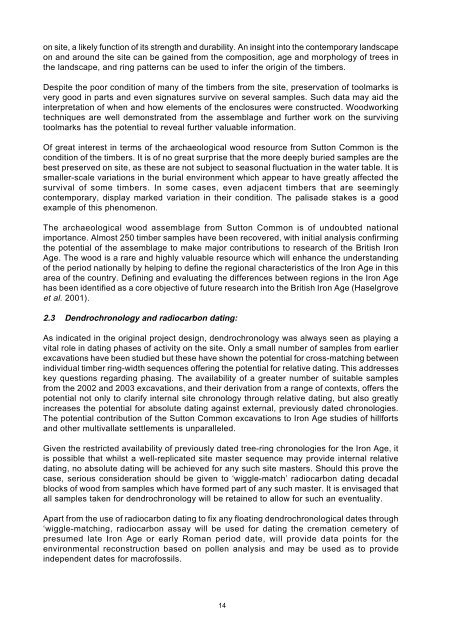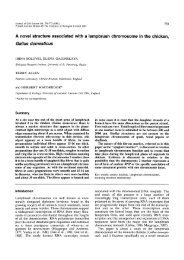Sutton Common Updated project design - University of Exeter
Sutton Common Updated project design - University of Exeter
Sutton Common Updated project design - University of Exeter
Create successful ePaper yourself
Turn your PDF publications into a flip-book with our unique Google optimized e-Paper software.
on site, a likely function <strong>of</strong> its strength and durability. An insight into the contemporary landscape<br />
on and around the site can be gained from the composition, age and morphology <strong>of</strong> trees in<br />
the landscape, and ring patterns can be used to infer the origin <strong>of</strong> the timbers.<br />
Despite the poor condition <strong>of</strong> many <strong>of</strong> the timbers from the site, preservation <strong>of</strong> toolmarks is<br />
very good in parts and even signatures survive on several samples. Such data may aid the<br />
interpretation <strong>of</strong> when and how elements <strong>of</strong> the enclosures were constructed. Woodworking<br />
techniques are well demonstrated from the assemblage and further work on the surviving<br />
toolmarks has the potential to reveal further valuable information.<br />
Of great interest in terms <strong>of</strong> the archaeological wood resource from <strong>Sutton</strong> <strong>Common</strong> is the<br />
condition <strong>of</strong> the timbers. It is <strong>of</strong> no great surprise that the more deeply buried samples are the<br />
best preserved on site, as these are not subject to seasonal fluctuation in the water table. It is<br />
smaller-scale variations in the burial environment which appear to have greatly affected the<br />
survival <strong>of</strong> some timbers. In some cases, even adjacent timbers that are seemingly<br />
contemporary, display marked variation in their condition. The palisade stakes is a good<br />
example <strong>of</strong> this phenomenon.<br />
The archaeological wood assemblage from <strong>Sutton</strong> <strong>Common</strong> is <strong>of</strong> undoubted national<br />
importance. Almost 250 timber samples have been recovered, with initial analysis confirming<br />
the potential <strong>of</strong> the assemblage to make major contributions to research <strong>of</strong> the British Iron<br />
Age. The wood is a rare and highly valuable resource which will enhance the understanding<br />
<strong>of</strong> the period nationally by helping to define the regional characteristics <strong>of</strong> the Iron Age in this<br />
area <strong>of</strong> the country. Defining and evaluating the differences between regions in the Iron Age<br />
has been identified as a core objective <strong>of</strong> future research into the British Iron Age (Haselgrove<br />
et al. 2001).<br />
2.3 Dendrochronology and radiocarbon dating:<br />
As indicated in the original <strong>project</strong> <strong>design</strong>, dendrochronology was always seen as playing a<br />
vital role in dating phases <strong>of</strong> activity on the site. Only a small number <strong>of</strong> samples from earlier<br />
excavations have been studied but these have shown the potential for cross-matching between<br />
individual timber ring-width sequences <strong>of</strong>fering the potential for relative dating. This addresses<br />
key questions regarding phasing. The availability <strong>of</strong> a greater number <strong>of</strong> suitable samples<br />
from the 2002 and 2003 excavations, and their derivation from a range <strong>of</strong> contexts, <strong>of</strong>fers the<br />
potential not only to clarify internal site chronology through relative dating, but also greatly<br />
increases the potential for absolute dating against external, previously dated chronologies.<br />
The potential contribution <strong>of</strong> the <strong>Sutton</strong> <strong>Common</strong> excavations to Iron Age studies <strong>of</strong> hillforts<br />
and other multivallate settlements is unparalleled.<br />
Given the restricted availability <strong>of</strong> previously dated tree-ring chronologies for the Iron Age, it<br />
is possible that whilst a well-replicated site master sequence may provide internal relative<br />
dating, no absolute dating will be achieved for any such site masters. Should this prove the<br />
case, serious consideration should be given to ‘wiggle-match’ radiocarbon dating decadal<br />
blocks <strong>of</strong> wood from samples which have formed part <strong>of</strong> any such master. It is envisaged that<br />
all samples taken for dendrochronology will be retained to allow for such an eventuality.<br />
Apart from the use <strong>of</strong> radiocarbon dating to fix any floating dendrochronological dates through<br />
‘wiggle-matching, radiocarbon assay will be used for dating the cremation cemetery <strong>of</strong><br />
presumed late Iron Age or early Roman period date, will provide data points for the<br />
environmental reconstruction based on pollen analysis and may be used as to provide<br />
independent dates for macr<strong>of</strong>ossils.<br />
14
















